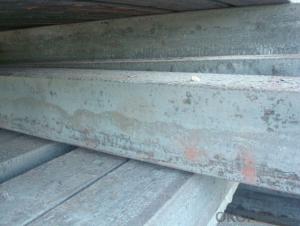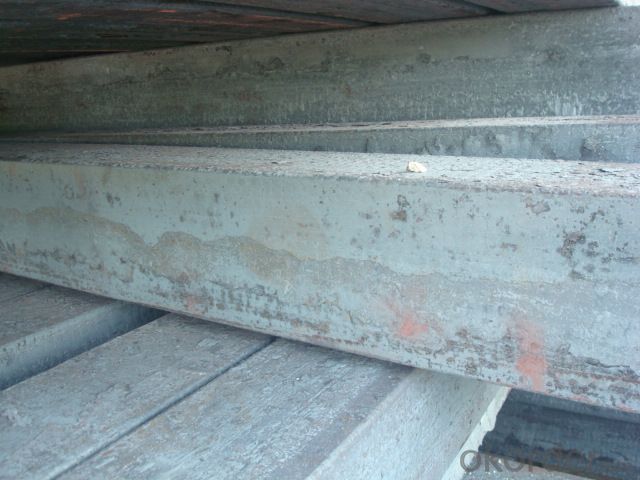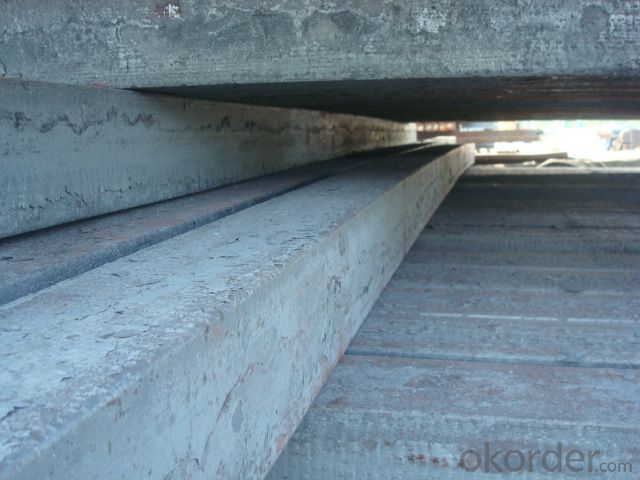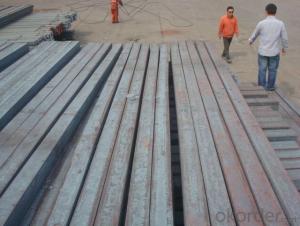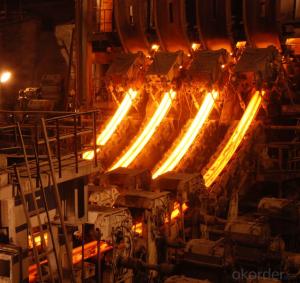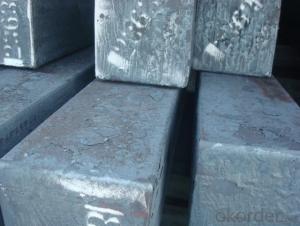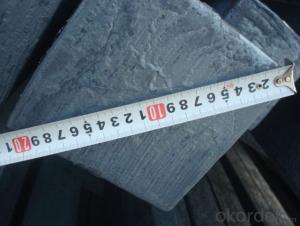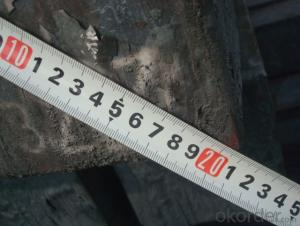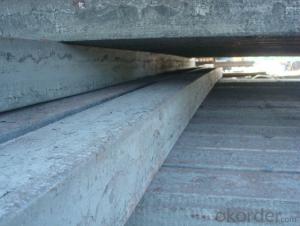Steel Billet Hot Rolled Q235/275 in Amazing Price
- Loading Port:
- Tianjin
- Payment Terms:
- TT OR LC
- Min Order Qty:
- 1000 m.t.
- Supply Capability:
- 50000 m.t./month
OKorder Service Pledge
OKorder Financial Service
You Might Also Like
1.Structure of Steel Billet
Steel billet(ingot) by cogging or breakdown of semi-finished products, is the raw material of all kinds of steel mill. Billet section of square, round, flat, rectangular and abnormity of several kinds of, mainly related to the shape of rolled products.
2.Main Features of Steel Billet
Rectangular billet continuous casting billet and mainly general carbon steel, low carbon low silicon cold-rolled material, high quality carbon structural steel, high strength low alloy steel, special steel, etc.
The billet is mainly divided into two kinds from the shape:
Slab: cross section width and height of the ratio of the larger, mainly used for rolling plate.
Billet: equal cross section width and height, or a huge difference, mainly used for rolling steel, wire rod. ,
Steel billets have distinct characteristics as compared with already furnished steel bars and products. Billets have a specific grain structure, which enables the metal to be processed more intricately. Steel billets are also known for their malleability and ductility, especially when exposed to varying temperatures during shaping and molding.
3.Steel Billet Images
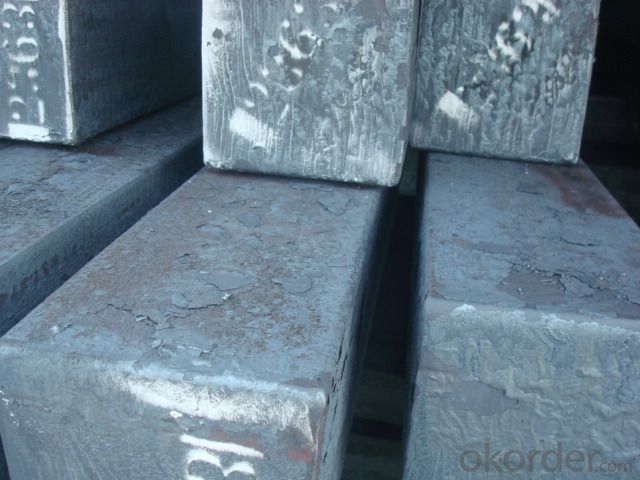
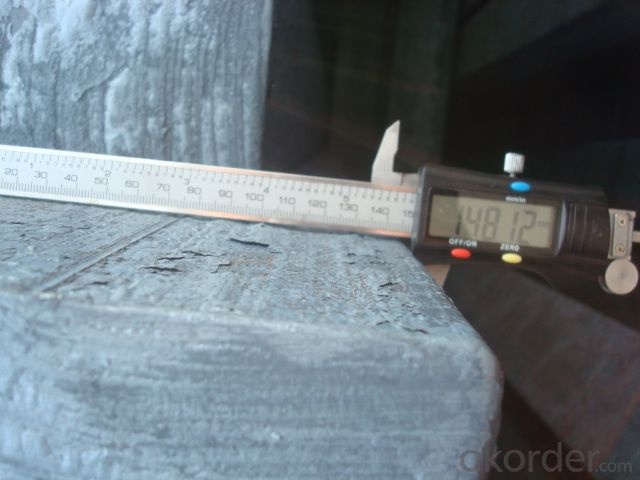
4.Usage of Steel Billet
Billets, or ingots (as they sometimes referred to), are not of practical use until they have been formed into more functional shapes and sizes. While they have already been put in the furnace, they still require a series of shaping and molding procedures such as hot and cold working, milling and cutting before they are sold in hardware stores, or used for different applications. The unformed billets, however, can be used in striking currency such as coins and as reserves, similar to gold bars.
5. Steel Billet Specification
Hot rolled billet steel
Size: 50x50mm-180x180mm
Steel Grade: 3SP, 5SP,Q195,Q235,Q255,Q275 Length:3m-12m
MOQ: 1000MT/size
Payment term: TT or LC
Packing: in bulk , bundle
Shipment: by container , bulk vessel
Packaging Details: bundles with steel strips or as customers's requirements
Delivery time: 15-30 days after the deposit
Loading port:Tianjin, or other port China
Origin :China
Inspection:Third party inspection before loading.
6.FAQ
We have organized several common questions for our clients,may help you sincerely:
1) How to guarantee the quality of the products?
We have established the international advanced quality management system,every link from raw material to final product we have strict quality test;We resolutely put an end to unqualified products flowing into the market. At the same time, we will provide necessary follow-up service assurance.
2)Do you have your own QC department?
Yes, we have, our QC department will inspect the goods during the process of mass production and after completion of production.
3)Do you have your own QC department?
Yes, we have, our QC department will inspect the goods during the process of mass production and after completion of production.
- Q: Can steel billets be used in marine environments?
- Yes, steel billets can be used in marine environments. Steel is a popular choice for various marine applications due to its strength, durability, and corrosion resistance properties. Steel billets, which are semi-finished products, can be further processed into various marine components such as ship hulls, offshore platforms, and marine structures. To withstand the harsh conditions of marine environments including exposure to saltwater, steel used in these applications is typically treated with anti-corrosion coatings or alloys. These protective measures help prevent the corrosion of steel and maintain its structural integrity, ensuring it can withstand the corrosive effects of seawater and other marine elements. Moreover, steel billets can undergo additional processes such as hot rolling, forging, or extrusion to shape them into the desired marine components. These processes further enhance the mechanical properties of the steel, making it suitable for marine applications where high strength and resistance to impact and fatigue are required. Overall, steel billets can be effectively used in marine environments, provided they are properly treated and processed to withstand the corrosive nature of seawater and meet the specific requirements of marine applications.
- Q: How are steel billets used in the manufacturing of heavy machinery?
- Steel billets are an essential element in the production of heavy machinery. These billets are semi-finished steel products that are either hot-rolled or forged into specific shapes, typically squares or rectangles. To start utilizing steel billets for heavy machinery, they must first be heated to a high temperature, which makes them easier to manipulate and work with. Once heated, the billets are shaped and formed through various processes like extrusion, rolling, or forging. This enables manufacturers to create the necessary components and parts for heavy machinery, including gears, shafts, frames, and structural elements. The use of steel billets in heavy machinery manufacturing is crucial due to steel's inherent properties. Steel is renowned for its strength, durability, and resistance to wear and tear. These characteristics make it an ideal material for heavy machinery that experiences intense forces, vibrations, and harsh operating conditions. Furthermore, steel billets offer versatility in terms of customization and design. Manufacturers can modify the shape, size, and composition of the billets to meet the specific requirements of the heavy machinery being produced. This adaptability allows for the creation of intricate and complex components that can withstand the demands of heavy-duty applications. Once the steel billets are shaped into the desired components, they undergo further processes like heat treatment, machining, and finishing. These additional steps enhance the mechanical properties and precision of the final products, ensuring that they meet the necessary specifications and standards for heavy machinery manufacturing. In conclusion, steel billets play a crucial role in the production of heavy machinery. Their malleability, strength, and customization options make them an ideal material for creating durable and reliable components that can withstand the demands of heavy-duty applications.
- Q: How are steel billets used in the manufacturing of pressure vessels?
- Pressure vessels require steel billets as a necessary part of their manufacturing process. These metal products are in a semi-finished state and are typically made through casting or extrusion. The billets are molded into a solid square or rectangular shape to ensure consistent and uniform material for further processing. To initiate the manufacturing process, the steel billets are heated to a specific temperature, making them more malleable and easier to handle. Once heated, they are placed into a forging machine, where intense pressure and shaping take place. This forging process effectively eliminates any defects or inconsistencies in the billet's structure, resulting in a stronger and more durable material. After the forging stage, the steel billets undergo additional processing using different techniques like rolling or machining. These techniques are employed to achieve the desired dimensions and shape required for pressure vessel fabrication. By refining the billet's surface finish and improving its mechanical properties, these techniques enhance the overall quality of the billet. Once the billets have been shaped and processed, they are cut into smaller sections that serve as the foundation for constructing pressure vessels. These sections are welded together to form the vessel's shell, ensuring a secure and tight seal to contain high-pressure fluids or gases. The use of steel billets in pressure vessel manufacturing is critical due to their superior strength, durability, and resistance to high-pressure environments. The uniformity and consistency of the billets provide a reliable material for fabricating vessels that can endure extreme conditions, guaranteeing the safety and integrity of the contents within. In conclusion, steel billets play a crucial role in the manufacturing of pressure vessels by providing the core components for constructing the vessel's shell. Through a series of heating, forging, and processing techniques, the billets are transformed into robust and enduring sections that are then welded together to form the final vessel. The utilization of steel billets ensures the structural integrity and dependability of pressure vessels, making them suitable for a wide range of industrial applications.
- Q: How are steel billets used in the manufacturing of telecommunications equipment?
- Steel billets are an essential component in the manufacturing of telecommunications equipment. These billets serve as the raw material that is shaped and transformed into various components used in telecommunications infrastructure. One of the primary uses of steel billets in telecommunications equipment manufacturing is in the production of towers and masts. These structures provide the necessary support for antennas and other equipment used in transmitting and receiving signals. Steel billets are melted and then forged or rolled into the desired shape to form the structural members of these towers, ensuring their strength and stability. Additionally, steel billets are also used in the manufacturing of cable trays and cable management systems. These components are crucial for organizing and protecting the vast network of cables that are used in telecommunications systems. Steel billets are processed and fabricated into cable trays, brackets, and supports, providing a sturdy and durable solution for managing the complex web of cables. Furthermore, steel billets find application in the production of enclosures and cabinets used to house sensitive telecommunications equipment. These enclosures provide protection from environmental factors such as dust, moisture, and temperature fluctuations. Steel billets are molded and shaped into the desired size and design, ensuring a robust and secure enclosure for the equipment. In summary, steel billets play a vital role in the manufacturing of telecommunications equipment. From towers and masts to cable trays and enclosures, these billets provide the foundation and structural integrity necessary for the reliable operation of telecommunications infrastructure.
- Q: How are steel billets used in the manufacturing of defense equipment?
- Steel billets are used in the manufacturing of defense equipment as they serve as the raw material for forging various components and parts. These billets are heated, shaped, and machined to create the necessary structures, such as gun barrels, armor plates, and gears, which are crucial for the production of durable and reliable defense equipment.
- Q: How are steel billets used in the production of pipes?
- Steel billets are an essential raw material in the production of pipes. They are used as a starting point for the manufacturing process, where they undergo various transformations to eventually become pipes. Firstly, steel billets are heated to a high temperature to make them malleable. This process, known as hot rolling, allows the billets to be shaped into long cylindrical forms. The heating also improves the steel's internal structure and removes any impurities. Once the billets are heated, they are sent through a series of rolling mills. These mills gradually reduce the billet's size and shape it into a round bar called a "bloom." The bloom is then further processed by passing it through a piercing mill, which creates a hollow cavity in the center. After the piercing process, the bloom is then elongated and shaped into a pipe while being continuously rolled. The elongation process is achieved by passing the bloom through a series of sizing mills, where it is gradually stretched and shaped into the desired pipe dimensions. This continuous rolling process ensures a uniform thickness and shape throughout the length of the pipe. Additionally, steel billets can also be used to produce seamless pipes. In this case, the billets are heated and pierced in a similar manner as described above. However, instead of being elongated through rolling, the pierced billet is further processed by being elongated and reduced in diameter using a process known as extrusion. This results in a seamless pipe with no welded joints, which is often preferred in industries such as oil and gas. Overall, steel billets play a crucial role in the production of pipes. They are transformed through heating, rolling, and shaping processes to create pipes of various sizes and types. These pipes are then used in various industries, such as construction, infrastructure, and energy, for transporting fluids and gases.
- Q: What are the different methods of steel billet surface plating?
- There are several different methods of steel billet surface plating, each with its own advantages and applications. Some of the most common methods include: 1. Electroplating: This is a widely used method where an electric current is used to deposit a layer of metal onto the surface of the steel billet. The billet is submerged in a solution containing metal ions, and when the current is applied, the metal ions are attracted to the steel surface, forming a thin coating. 2. Hot-dip galvanizing: In this method, the steel billet is dipped into a bath of molten zinc. The high temperature causes the zinc to bond with the steel, forming a protective layer. This process is commonly used for steel structures that will be exposed to harsh environments or corrosive elements. 3. Powder coating: This technique involves applying a dry powder to the surface of the steel billet, which is then heated to form a protective layer. Powder coating offers excellent durability, resistance to corrosion, and a wide range of color options. 4. Physical vapor deposition (PVD): PVD is a method where a thin film of metal is deposited onto the surface of the steel billet through a physical process such as evaporation or sputtering. This technique is commonly used for decorative purposes and to enhance the hardness and wear resistance of the steel surface. 5. Chemical conversion coating: This process involves treating the steel billet with a chemical solution that forms a protective layer on the surface. Common conversion coatings include phosphate and chromate coatings, which provide corrosion resistance and improve paint adhesion. 6. Thermal spraying: In this method, a heated material, typically a metal or ceramic powder, is sprayed onto the steel billet surface using a high-velocity gas or flame. The sprayed material forms a coating, providing enhanced protection against wear, corrosion, and high temperatures. Each of these methods has its own benefits and is suitable for different applications. The choice of plating method depends on factors such as the desired level of protection, cost, aesthetics, and specific requirements of the steel billet's end use.
- Q: What are the different surface defects that can be found in steel billets?
- There are several common surface defects that can be found in steel billets. These defects can occur during the manufacturing process or due to handling and transportation. Some of the different surface defects that can be found in steel billets include: 1. Scale: Scale is a type of surface oxidation that appears as a thin layer of iron oxide on the surface of the billet. It can occur during the heating and cooling process and can be removed through mechanical or chemical cleaning methods. 2. Cracks: Cracks can occur due to the improper cooling of the billet or excessive stress during handling. They can either be longitudinal or transverse, and their severity depends on the depth and length of the crack. Cracks can weaken the structural integrity of the billet and should be carefully inspected and repaired. 3. Inclusions: Inclusions are particles or impurities that are trapped within the steel during the manufacturing process. They can be non-metallic or metallic in nature and can affect the mechanical properties of the billet. Inclusions can be categorized as slag inclusions, gas porosity, or non-metallic inclusions like oxides and sulfides. 4. Decarburization: Decarburization is a surface defect that occurs due to the loss of carbon on the surface of the billet during the heating process. It can result in reduced hardness and strength of the steel in the affected area. Decarburization can be minimized by controlling the heating and cooling process and using protective atmospheres. 5. Laminations: Laminations are layers or sheets of non-metallic material that are trapped between the layers of steel during the manufacturing process. They can cause weak spots in the billet and can lead to failure under stress. Laminations can be detected through non-destructive testing methods and should be removed or repaired. 6. Pitting: Pitting is a localized corrosion phenomenon that appears as small pits or cavities on the surface of the billet. It can occur due to exposure to corrosive environments or improper storage conditions. Pitting can reduce the lifespan of the billet and should be treated to prevent further corrosion. It is important to note that these surface defects can vary in severity and impact the quality and performance of the steel billet. Regular inspection, testing, and quality control measures are necessary to identify and address these defects to ensure the integrity of the steel billet and the final products made from it.
- Q: What are the different methods of surface inspection for steel billets?
- Steel billets can undergo various methods of surface inspection to identify defects or irregularities. These include visual inspection, magnetic particle inspection, liquid penetrant inspection, ultrasonic inspection, and eddy current inspection. The simplest and most commonly used method is visual inspection, where inspectors visually examine the billet surface for visible defects such as cracks, pits, or irregularities. This method relies on the expertise and experience of the inspector. Magnetic particle inspection involves the use of magnetic fields and particles to detect surface and near-surface defects. By applying a magnetic field and particles to the billet surface, any defects attract particles, making them visible under proper lighting. Liquid penetrant inspection is another method used to detect surface defects. It involves applying a penetrant to the surface, which seeps into defects. After removing excess penetrant, a developer is applied to draw out the penetrant from the defects, making them visible. Ultrasonic inspection uses high-frequency sound waves to detect internal and surface defects. Sound waves are emitted into the billet using a transducer, and the reflected waves are analyzed to identify defects such as cracks, voids, and inclusions. Eddy current inspection is a non-destructive testing method that uses electromagnetic induction to detect surface defects. By moving a probe over the billet surface and passing an alternating current through it, any irregularities or defects disrupt the current flow, which can be detected and analyzed. Each method has its own advantages and limitations, and the choice depends on specific inspection requirements and constraints. Manufacturers utilize these methods to ensure the quality and reliability of steel billets before further processing or use in various applications.
- Q: What are the different types of steel billets?
- There exists a variety of steel billets, each possessing its own distinct attributes and applications. Among them, the most commonly encountered types are: 1. Carbon Steel Billets: Constructed from iron and carbon, these billets are widely employed due to their exceptional strength and durability. Consequently, they find utility in numerous sectors, including construction, automotive, and machinery manufacturing. 2. Alloy Steel Billets: By incorporating diverse alloying elements such as chromium, nickel, or manganese into carbon steel, alloy steel billets exhibit improved properties such as enhanced strength, hardness, and resistance to corrosion. Thus, they are frequently employed in industries necessitating high-performance materials, such as aerospace, oil and gas, and power generation. 3. Stainless Steel Billets: These billets are manufactured with a high chromium content, resulting in superior resistance to corrosion and oxidation. They are typically employed in applications where hygiene, durability, and aesthetic appearance are of utmost importance, such as food processing, medical equipment, and architectural structures. 4. Tool Steel Billets: Engineered to possess remarkable hardness, wear resistance, and heat resistance, tool steel billets are widely utilized in the fabrication of cutting tools, molds, and dies for various industries, including automotive, manufacturing, and construction. 5. Electrical Steel Billets: Comprised of low carbon steel with unique magnetic properties, electrical steel billets find application in the production of electrical equipment, such as transformers, motors, and generators. Their significance lies in their ability to minimize energy loss and exhibit high magnetic permeability. 6. High-speed Steel Billets: These billets are alloyed with elements such as tungsten, molybdenum, and cobalt, which enable them to retain their hardness and strength under high temperature conditions. They are extensively employed in the manufacture of cutting tools necessary for high-speed cutting operations, including drills, milling cutters, and taps. These examples represent only a fraction of the diverse range of steel billets available. The selection of a particular steel billet hinges upon the specific requirements of the application, such as strength, durability, corrosion resistance, or specialized properties essential for specific industries.
Send your message to us
Steel Billet Hot Rolled Q235/275 in Amazing Price
- Loading Port:
- Tianjin
- Payment Terms:
- TT OR LC
- Min Order Qty:
- 1000 m.t.
- Supply Capability:
- 50000 m.t./month
OKorder Service Pledge
OKorder Financial Service
Similar products
Hot products
Hot Searches
Related keywords

